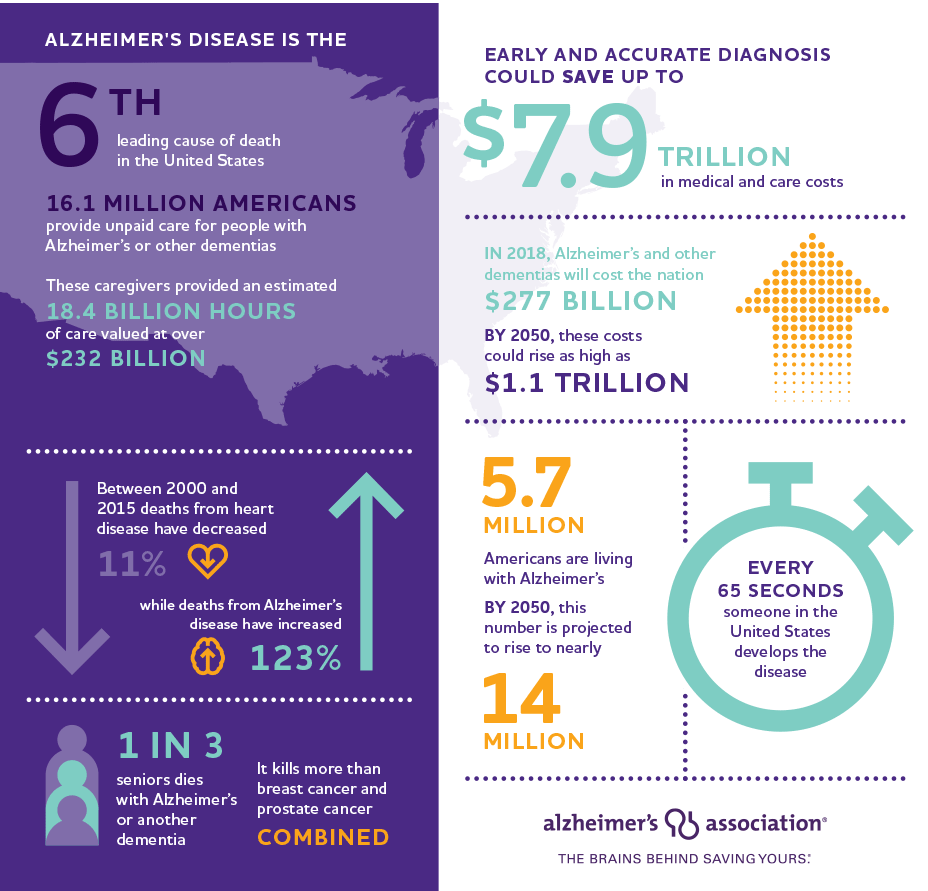QUICK FACTS
PREVALENCE
Every 65 seconds someone in the United States develops Alzheimer’s Disease.
The number of Americans living with Alzheimer’s disease is growing — and growing fast. An estimated 5.7 million Americans of all ages have Alzheimer’s disease.
An estimated 5.7 million Americans of all ages are living with Alzheimer’s dementia in 2018. This number includes an estimated 5.5 million people age 65 and older and approximately 200,000 individuals under age 65 who have younger-onset Alzheimer’s.
- One in 10 people age 65 and older (10 percent) has Alzheimer’s dementia.
- Almost two-thirds of Americans with Alzheimer’s are women.
- Older African-Americans are about twice as likely to have Alzheimer’s or other dementias as older whites.
- Hispanics are about one and one-half times as likely to have Alzheimer’s or other dementias as older whites.
As the number of older Americans grows rapidly, so too will the numbers of new and existing cases of Alzheimer’s. Today, someone in the United States develops Alzheimer’s every 65 seconds. By mid-century, someone in the United States will develop the disease every 33 seconds.
MORTALITY
1 in 3 seniors dies with Alzheimer’s disease or another dementia.
Alzheimer’s disease is the only top 10 cause of death in the United States that cannot be prevented, cured or even slowed.
- Alzheimer’s disease is the sixth-leading cause of death in the United States, and the fifth-leading cause of death among those age 65 and older. It also is a leading cause of disability and poor health.
- Although deaths from other major causes have decreased significantly, official records indicate that deaths from Alzheimer’s disease have increased significantly. Between 2000 and 2015, deaths from Alzheimer’s disease as recorded on death certificates increased 123 percent, while deaths from the number one cause of death (heart disease) decreased 11 percent.
- Among people age 70, 61 percent of those with Alzheimer’s are expected to die before the age of 80 compared with 30 percent of people without Alzheimer’s — a rate twice as high.
CAREGIVERS
18.4 billion hours of care, valued at over $232 billion, are provided by family and other unpaid caregivers.
Eighty-three percent of the help provided to older adults in the United States comes from family members, friends, or other unpaid caregivers. Nearly half of all caregivers who provide help to older adults do so for someone with Alzheimer’s or another dementia.
-
- About one in three caregivers (34 percent) is age 65 or older.
- Approximately two-thirds of caregivers are women; more specifically, over one-third of dementia caregivers are daughters.
- Approximately one-quarter of dementia caregivers are “sandwich generation” caregivers — meaning that they care not only for an aging parent, but also for children under age 18.
Alzheimer’s takes a devastating toll on caregivers. Compared with caregivers of people without dementia, twice as many caregivers of those with dementia indicate substantial emotional, financial and physical difficulties.
Of the total lifetime cost of caring for someone with dementia, 70 percent is borne by families — either through out-of-pocket health and long-term care expenses or from the value of unpaid care.
COST TO NATION
$341,840 is the approximate lifetime cost of care for an individual living with dementia in 2018.
Alzheimer’s places a huge burden on the health care system, with annual costs exceeding a quarter of a trillion dollars.
In 2018, the direct costs to American society of caring for those with Alzheimer’s will total an estimated $277 billion, including $186 billion in Medicare and Medicaid payments. Unless something is done, in 2050, Alzheimer’s is projected to cost more than $1.1 trillion (in 2018 dollars). This dramatic rise includes more than four-fold increases both in government spending under Medicare and Medicaid and in out-of-pocket spending.
The costs of health care and long-term care for individuals with Alzheimer’s or other dementias are substantial. Dementia is one of the costliest conditions to society.
- People with Alzheimer’s or other dementias have twice as many hospital stays per year as other older people.
- Medicare beneficiaries with Alzheimer’s or other dementias are more likely than those without dementia to have other chronic conditions.
- People with Alzheimer’s or other dementias make up a large proportion of all elderly people who receive adult day services and nursing home care.
SPECIAL REPORT — ALZHEIMER’S DISEASE: THE NEXT FRONTIER
Early diagnosis of Alzheimer’s provides a number of important benefits to diagnosed individuals, their caregivers and loved ones, as well as society as a whole.
The development of biomarkers for Alzheimer’s disease is making it possible to detect Alzheimer’s disease and provide an accurate diagnosis earlier than at any other time in history. In addition to providing significant medical, emotional and social benefits and facilitating participation in important clinical trials, early diagnosis enables individuals to prepare legal, financial and end-of-life plans while they are still cognitively able to make decisions and share their wishes.
Early diagnosis, even without biomarker evidence for a specific underlying cause, will also yield significant cost savings in medical and long-term care for both the U.S. government and diagnosed individuals.
Among all Americans alive today, if those who will get Alzheimer’s disease were diagnosed in the mild cognitive impairment (MCI) stage — before dementia — it would collectively save $7 trillion to $7.9 trillion in health and long-term care costs.
